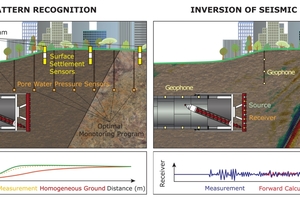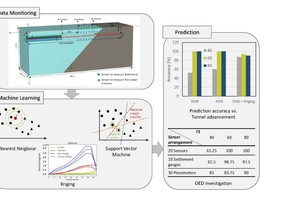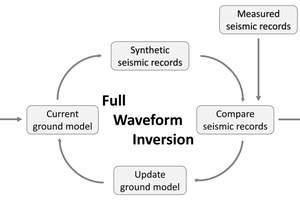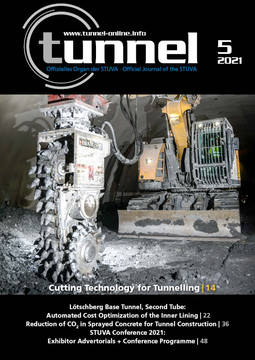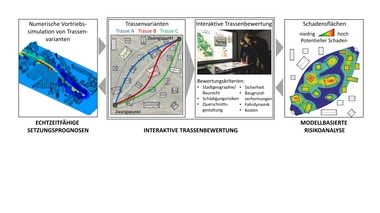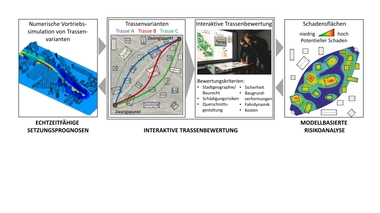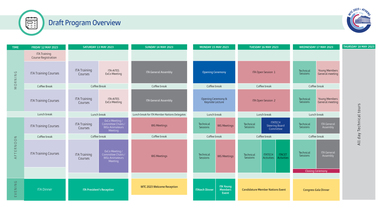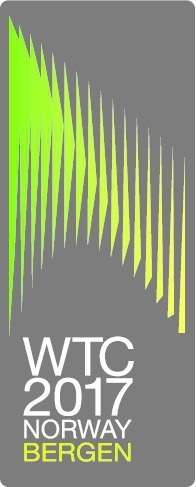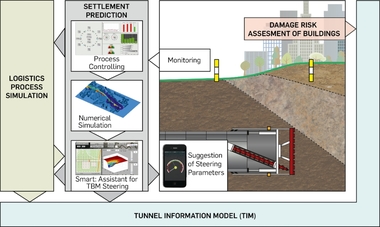Advanced Exploration Concepts in Tunnelling
This article presents a three-staged exploration algorithm for mechanized tunnelling, which combines two different techniques. Firstly, a supervised machine learning methodology utilizes common monitored data like pore water pressures and settlements to develop an initial image of the subsoil. Afterwards, two different full waveform inversion algorithms are applied using seismic records from induced seismic waves in order to improve the image of the subsoil. The different stages of the proposed algorithm will increase the resolution of the stratigraphy.
1 Introduction
Along the trajectory in mechanized tunnelling there are many spatial geological sudden changes in the surroundings that may not be detected in the initial geological surveys. To tackle this issue, the combination of two different exploration concepts in the framework of mechanized
excavation of shallow tunnels is proposed (Fig. 1).
Firstly, pore water pressure and ground settlements are measured along and above the planned tunnel track to provide a first prediction of changes in the geological formation via machine learning (see Fig. 1 left). Accordingly, seismic records are analyzed by full waveform inversion (FWI) to identify the spatial distribution of elastic ground properties (see Fig. 1 right).
2 First Exploration by Pattern Recognition
In the last decade, artificial intelligence has shown promising performance in various practical and scientific aspects. To cope with the existing uncertainties in geological alteration ahead of a TBM, an employment of machine learning techniques is proposed.
In this study, the geological anomalies are obtained based on the monitored variation in ground settlement and pore water pressure in the surrounding by the boring machine advancement. In the proposed supervised learning process, different subsoil arrangements are treated as different classes, and monitored soil reactions induced by the TBM advancement are considered as learning features. Afterwards, different supervised learning techniques are investigated to achieve an accurate estimation of the soil stratum state in front of the tunnel face (see Fig. 2). Considering different monitoring campaigns in the framework of an optimised experimental design [1] may improve the accuracy of the proposed method and leads to more reliable predictions. The obtained estimation of stratigraphy will be used as the basic model for the FWI techniques.
3 Exploration Improvement by
Full Waveform Inversion
In the proposed concept, two different methods to invert for ground models based on seismic records are applied. The FWI is an iterative process to reduce the difference of the measured seismic records and the simulated records of a parameterized ground model to reconstruct a realistic ground model (see Fig. 3). Any a priori information given by the machine learning algorithm improves the inversion process by giving rise to a good initial model or for choosing a proper parameterization of the ground.
Firstly, unscented hybrid simulated annealing (UHSA) [2] is applied, which combines the unscented Kalman filter with the metaheuristic search algorithm simulated annealing. The resulting algorithm is a non-deterministic and derivative-free global optimization scheme to invert the parameters describing the disturbance effectively and precisely. Including knowledge from the results of the pattern recognition via artificial intelligence, a parametrization of the disturbance’s geometry with only a low number of parameters is implemented. If the chosen parametrization is able to capture the properties of the disturbance, the inversion results may be highly precise.
If the parameterization used in UHSA is not able to capture all relevant characteristics of the disturbance, the adjoint method is able to improve the ground model, utilizing the final model of UHSA as the initial model. Here, no a priori assumptions are needed since all material properties are parameterized over the entire domain. For the adjoint FWI two different approaches are proposed. On the one hand, a nodal discontinuous Galerkin finite element method with tetrahedral elements can be used, which calculates synthetic seismic records in the time-domain [3]. On the other hand, a finite element model that solves the elastic wave equation in the frequency domain by utilizing hierarchical shape functions may be applied [4]. In this way, it is possible to sharpen the reconstructed picture of the obstacles as well as identifying smaller inhomogeneities.
4 Summary
We have proposed a three-staged algorithm for the exploration of unknown obstacles in mechanized tunnelling. The algorithm is designed to reconstruct a rough picture of the obstacles first and to refine this picture with higher stages. The computational demand increases with each stage; thus, the algorithm can be stopped after each stage if the desired resolution is obtained. Another advantage is the combination of information from two different independent physical concepts: Settlements and pore-water pressure changes due to the excavation of the tunnel itself and propagation of seismic waves through the soil to be excavated.
identification in mechanized tunneling. Underground Space, 3 (1), 2018, pp. 34-44. DOI: 10.1016/j.undsp.2018.01.004
detection using seismic signals. Mechanical Systems and Signal Processing, 133, 2019, 106250. DOI: 10.1016/j.ymssp.2019.106250
International Journal of Civil Engineering, 17, 2019, pp. 19-32. DOI: 10.1007/s40999-018-0319-7

